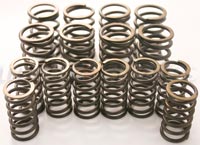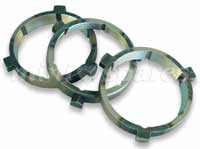
This valve spring set has been developed to fit standard sized top caps, and cope with mild/fast road rpm and high valve lifts, without crushing, of up to 0.475” without modifications when fitted to a cylinder head that has standard or near standard valve spring heights.
However, where possible, it is always advantageous to correct and match the valve spring heights (measured from the spring seat in the head to the underside...
Read more
C-22A1741 steel baulk rings are direct replacement for the sintered type, which have been used for all standard production uses for the last few decades.
Under competition use the sintered type could either break through being to brittle and of limited metal integrity or simply wear out quickly. Minispares looked at the old pre 1970 steel type baulk rings used so successfully on the Monte Carlo and rally cars of that time where...
Read more
Modified to give maximum performance gain for cost.
Inlet Valves: 35.6mm(1.401") dia. TAM1059
Exhaust Valves: 29.2mm(1.150") dia. TAM1061
Chamber Volume: Nominal 21cc Modified to give maximum performance gain for cost. Combustion chambers, inlet and exhaust ports extensively re-worked. Smoothed finish in ports - not mirror-finish polished to minimise drag. Multi-angle valve seats in head. Super-quality MG Metro valves modified to increase airflow. Combustion chamber volume used to give slight static compression ratio increase over standard. Head mods employed greatly increase volumetric efficiency...
Read more
This valve spring set has been developed to fit standard sized top caps, and cope with fast road/rally rpm and high valve lifts, without crushing, of up to 0.495” without modifications when fitted to a cylinder head that has standard or near standard valve spring heights. However, where possible, it is always advantageous to correct and match the valve spring heights (measured from the spring seat in the head to the underside of the spring retainer cap), as these will vary particularly where new valve seats are cut. Read more
For many, trying to make an informed decision about which type of pistons they should use for their application is a very difficult thing to do. Mostly you have to rely on guidance from a very few sources such as engine builders and Mini spares specialists, who are most likely to recommend whatever it is they use or sell.
And that is not necessarily a bad thing where those companies have strong reputations for good quality products. But even those specialists may not know all that much about the pistons they use or sell. Particularly since trying to get any really useful information out of the manufacturers concerned is practically impossible. Try contacting AE Hepolite technical. Getting hold of someone takes real perseverance. Having achieved that meagre goal, enquiring about piston specification gets those ‘lemon sucking’ sorts of noises – anybody would think you are asking for the Holy Grail! So I’m going to try and cut through the techno-babble to help you identify and know what is what. Read more
Under 'Pistons - Favourable features for maximum performance' it would seem that the Mega pistons fit the bill just about spot on for all but perhaps the most extreme of racing engines. Or are they? Having used these pistons in all sizes from +0.020" to 73.5mm in all aspects of use - road/street to full race I am now in a position to give a report on their performance. Some have reservations about using the pistons in racing engines because they are a few grams heavier than other pistons available, and they are cast as opposed to forged. However, Mini Spares recruited the AE Hepolite Group for their unquestionable and renowned design and manufacturing expertise. The goal was to produce the most robust piston possible given reasonable cost and weight limits. Applying current technological advances incorporating their very latest hi-spec AE109TF lightweight alloy and special double heat treatments, the result is an extremely durable piston that will withstand greater cylinder pressures at higher rpm than any other currently available. Read more
The over-riding factor that influences just what is best for an A-Series engine is the block's propensity for flex at higher rpm, and the crank's equal propensity for flex at the same sort of rpm levels. Both combine to require a piston that is as stable as possible to maintain effective and consistent ring-seal performance. Reduced ring seal equals dramatically reduced performance. And none of this is at all helped by the relatively enormous distance from the wrist pin centre to crown height on most A-series pistons. Overall shape For the longest time, pistons were made round (well, 'ish' anyway) and straight sided (again - 'ish' is applicable here too) to form a cylinder, the top closed in to retain the all-important fuel/mixture charge; mainly because this was the simplest shape that would fill/block off the cylinder (bore) in an engine to greatest effect for minimum outlay. Read more
Whatever else owners do to their Minis by way of interior/exterior modifications or none at all, a very large proportion desire and search for an increase in engine performance.
See bottom for useful part numbers.
Now this may not be super-sonic speed-inducing power, it could just as well be for maximum economy. In either case, it's the engines volumetric efficiency (VE) under scrutiny - it's ability to breath in as much correctly proportioned air/fuel mix as possible in any given situation. Although the induction/exhaust system plays an important part, there are effectively two major factors that dictate performance increases - the camshaft and cylinder head. The induction and exhaust elements (stage one kits, exhaust systems, etc.) and camshafts are covered in various other articles in my 'Corner'. So here we'll have a look at cylinder heads and dispel some of the myths and legends surrounding them.
Read moreYes, contrary to what many say/express, all cranks are forged. None are cast. They wouldn't last 2 minutes in an engine if they were cast - they'd be way too brittle. Below is a list of crankshaft identification data by forging or stamped numbers - yes, contrary to what many say/express, all cranks are forged. None are cast. They wouldn't last 2 minutes in an engine if they were cast - they'd be way too brittle. The differences are in the material used, finish machining detail and any heat treatments applied. It is by no means complete and utterly correct/infallible since Austin/Morris, British Leyland, Leyland cars, Austin Rover, rover, et al were seriously prone to not adhering to specifications and applications lists. But it is better than nothing at all! 22A62 850cc - Early type with oil feed for primary gear, 1.375" dia. tail 22A63 850cc - Early type with oil feed for primary gear, 1.375" dia. tail Read more

